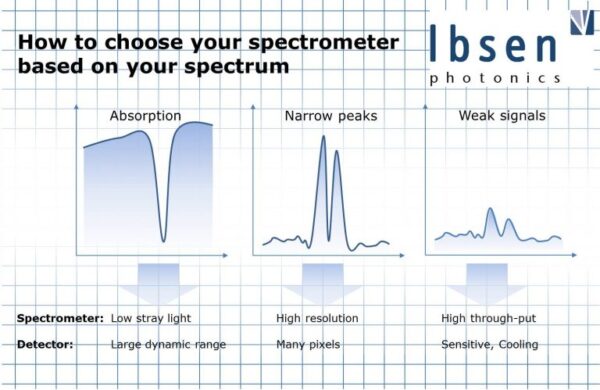How to choose a spectrometer
The basic parameters you need to know before choosing a suitable spectrometer are:
- Wavelength range
- Resolution
For instance, if you need to analyze color you need a spectrometer that covers the visible spectrum from approx. 400 – 700 nm.
The resolution is the spectrometer’s ability to distinguish between two closely spaced wavelengths. So, if your spectrum has some sharp peaks that are separated by say 0.5 nm or more, you need a spectrometer with at least 0.5 nm resolution.
Some applications (like Raman and IR spectroscopy) will not list the wavelength range and resolution in nanometer (nm) directly but rather in terms of inverse cm (cm-1). For Raman you can use our RamanShift calculator to convert back and forth between nm and cm-1.
Even though you know your wavelength range and resolution there are still a lot of possible spectrometer design options. So your final choice of spectrometer will depend on the importance of parameters such as overall Size, Cost, Speed, Sensitivity, Signal-to-Noise Ratio, Dynamic range, Linearity, Thermal Stability, Robustness. Below, you can find some general guidelines that may help you determine what kind of spectrometer parameters you should focus on for you application.

Check out the different spectrometer characteristics below:
If you need a compact spectrometer you should in general go for:
- High grating dispersion
- Small detector size
- Low numerical aperture/high f-number
If you need a low cost spectrometer you should in general go for:
- Small size spectrometer
- Low-end, non-cooled CCD/CMOS-based detector or a Photo-Diode array
- Low resolution spectrometer
If you need a fast spectrometer you should in general go for:
- High through-put spectrometers
- Transmission grating based
- High NA / Low f-number
- Few optical elements (preferably lenses)
- High-speed, non-cooled cameras
If you have very little light from your sample you need a highly sensitive spectrometer and you should in general go for:
- High throughput spectrometers
- Transmission grating based
- High NA / Low f-number
- Few optical elements (preferably lenses)
- A wide and tall input slit
- Cooled camera/detector that enable long integration time
- Highly sensitive CCD (or CMOS) detector with tall pixels
If signal levels have to be very stable over time you have several options depending on the actual signal level and balance of cost versus performance:
If your signal level is very weak and tends to drown in the noise:
- High through-put spectrometers
- Transmission grating based
- High NA / Low f-number
- Few optical elements (preferably lenses)
- A wide and tall input slit
- Cooled CCD/CMOS detectors with tall pixels that allow long integration time with low noise
If your signal level is very weak but, you also need a low cost solution:
- High through-put spectrometers
- Transmission grating based
- High NA / Low f-number
- Few optical elements (preferably lenses)
- Non-cooled CCD/CMOS detectors where you average over many short integration periods
If your signal level is stronger:
- High through-put spectrometers
- NMOS detectors with very low noise
If there are large (several orders of magnitude) variations in your signal levels you should in general go for:
- Low stray-light spectrometers
- Holographic, Master gratings rather than replicated, ruled gratings
- As few optical surfaces as possible
- Bandpass filters to block un-wanted light
- NMOS detectors with very large dynamic range or Non-cooled CCD/CMOS detectors where you average over many short integration periods.
If you require a linear relation between signal level and integration time you should in general go for:
- NMOS/BT-CCD detectors with very good linearity or
- CCD/CMOS detectors where you make a software correction for linearity.
If your spectrometer should operate under varying temperature conditions you should in general go for:
- Spectrometers with low wavelength and power shift vs. temperature
- Lens-based, tele-centric rather than mirror-based spectrometers
- All-dielectric, transmission grating based rather than reflection grating based spectrometers
- Thermally stable mounting methods
- Short integration time or temperature controlled detectors if you need longer integration time
If your spectrometer should operate under demanding environmental conditions you should consider some of the following:
- Spectrometers with low wavelength and power shift vs. external impacts
- Lens-based, tele-centric rather than mirror-based spectrometers
- Transmission grating based rather than reflection grating based
- Environmentally qualified mounting methods for optics and gratings
- Short integration time and/or temperature controlled detectors if you need longer integration time
Want to know more?
For further information see below.